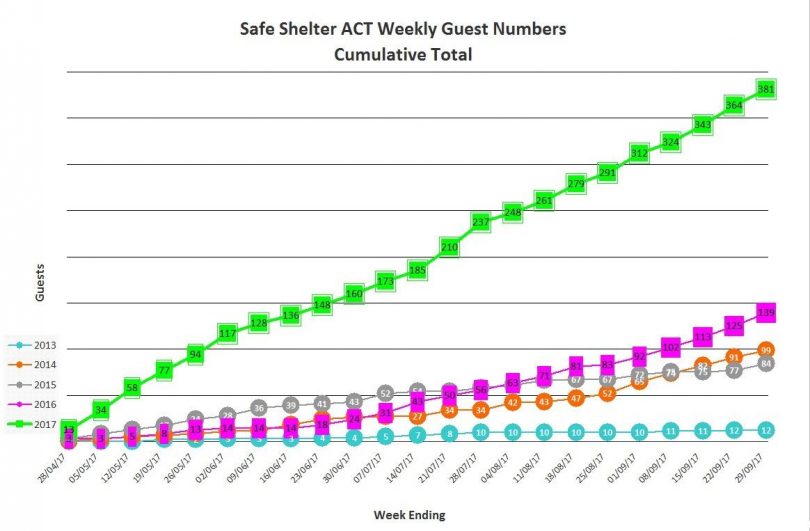
The loss of inner-city public housing appears to have contributed to a spike in the number of homeless men using overnight shelter in church halls last winter, with demand almost tripling.
Safe Shelter ACT, which provided shelter five nights a week across three church halls last winter, said feedback from guests suggested that many had been couch surfing with public housing residents who have been relocated to suburban sites.
Safe Shelter’s Richard Griffiths said these hidden homeless either could not follow their hosts to the new sites or preferred to be close to the city where there were services such as Safe Shelter.
He said the anecdotal evidence suggested that the scale of homelessness in Canberra was greater than recognised and resources had failed to keep pace with the need, with the Government-funded Samaritan House providing only 12 beds for permanent emergency shelter.
Mr Griffiths said the ACT Government needed to provide or fund more permanent emergency shelter but he was not hopeful that the Government’s Affordable Housing Summit on 17 October would result in any action.
The numbers of men seeking shelter with Safe House had almost tripled this year.
During the 23 weeks from 24 April to 29 September its more than 100 volunteers provided 381 “bed-nights” for homeless men to sleep on church hall foors at St Columba’s Uniting Church and the Salvation Army in Braddon, and at All Saints Anglican Church in Ainslie.
On average, over the 115 nights, there were 3.31 guests per night, while on some nights there were six or seven guests. The maximum that can be accommodated in a hall is eight.
In 2016 with just the one shelter at St Columba’s open for three nights a week, Safe Shelter accommodated 139 guests, an average of 2.01 guests for each of the 69 nights.

Mr Griffiths said the increase in 2017 was obviously greater than might have been expected in going from three to five nights per week, even allowing for the fact that some sleeping-rough homeless might have been more likely to give up a “good spot” on the streets in 2017 to come to a safe, warm, hall because one was now available more frequently.
Next winter, starting on 22 April 2018 and closing 29 September 2018, Safe Shelter will operate seven nights a week and require more volunteers.
Mr Griffiths said the ACT hadn’t expanded the number of permanent emergency beds since 1995, when Samaritan House was opened, and before that St Vincent de Paul ran its own shelter in Turner with only 12 beds.
“Effectively, we’ve had the same number of emergency beds for 40 years,” Mr Griffith said.
Safe Shelter was evolving beyond its original mission to provide shelter on cold winter nights.
“Safe Shelter was set up so if somebody was made homeless before 10 at night they could go somewhere and sleep and sort things out in the morning but instead of that we seem to be providing semi-permanent accommodation for people,” Mr Griffith said.
Without more permanent arrangements people were at risk of quickly sliding into sleeping rough and losing touch with society.
“You have the people who are homeless tonight and someone’s got to do something pretty quickly about them or they will quickly get used to sleeping on the streets,” Mr Griffiths said. “They won’t be able to hold down a job, they’ll become dirty and paranoid.”
Those with mental health issues also required permanent shelter to continue taking medication.
“We’re just exacerbating these sorts of problems by not providing emergency shelter,” Mr Griffiths said.
Next winter All Saints will open on Sunday and Monday nights; St Columba’s on Tuesday, Wednesday and Thursday nights; and the Salvation Army’s Canberra City hall will open on Friday and Saturday nights.
Safe Shelter said evening induction courses for the more than 140 volunteers required to run the shelters would start in March 2018.
Volunteers must agree to do one night per month in a shelter, on a night selected by themselves. Expressions of interest should be e-mailed to safeshelteract@gmail.com
Is the Government doing enough to prevent homelessness? What more could it do? Will the coming housing summit make a difference?












